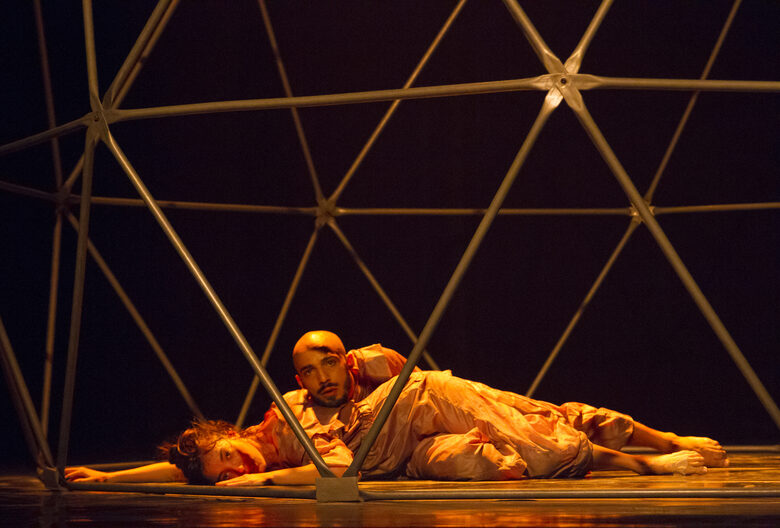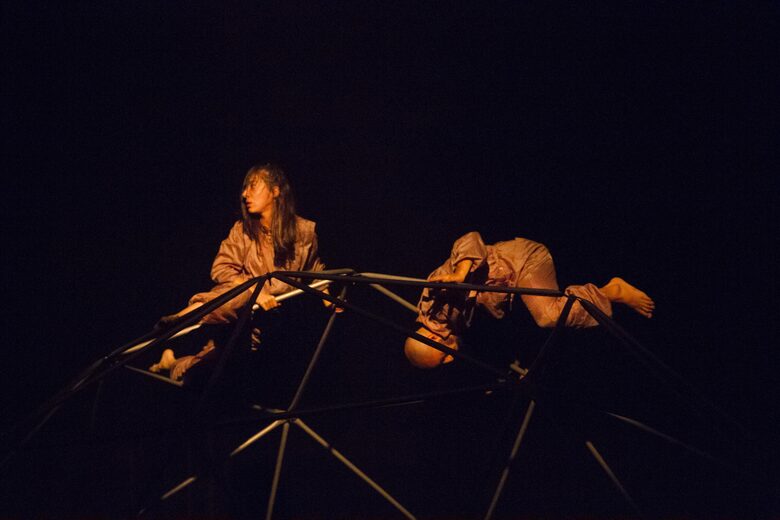Published on June 20, 2025.
This is also what Look at Me, by Sutil Companhia de Dança, is about. In Ádia Anselmi’s choreography (performed with Rubens Vital), two bodies image/react/interact. They see each other and, in seeing, are seen. And by being seen, they cross, shape, and realize one another. It’s not that they exist only through the gaze of the other (whether it’s their stage partner or us, the audience), but rather that they exist differently because of that gaze.
Thus, gesture, movement, and gaze become three vectors constantly at play throughout the choreography. The weight and tone of the bodies influence the dance as much as the seemingly ethereal, subjective, and metaphysical quality of the gaze. On stage, we see two bodies navigating their relationship: drawing near and pulling away; dancing the same steps in unison or each following their own path — sometimes complementing, sometimes freeing themselves. The desire to be pierced by the other, to be transformed into something entirely new, contrasts with the desire to pierce and transform the other — and also with the desire to remain independent, untouched. But is it really possible to remain untouched by someone after being seen?
Surrounding and towering above the dancers is a geodesic dome by Max Delly — a metaphor for the gaze itself: some parts are revealed, others remain hidden. Is it possible to truly see someone? To see them completely? The structure enables new gestures and spatial explorations, but also imposes limits. To see, to be seen, and to remain hidden — this is a game of exchange, negotiation, loss, and gain. One cannot become something without ceasing to be what they once were. One cannot act without giving up prior possibilities.
This dynamic of accumulation, subtraction, and transformation speaks as much to interpersonal relationships (I am what I am, but also what the other sees in me — and perhaps even what I never saw in myself) as it does to our relationship with art.
The stage offers a wide range of symbols, codes, and possible paths for connection and understanding — all of which are only completed through the observer's gaze. What unfolds on stage are the symbolic and subjective worlds of Ádia and Rubens — but also mine. My gaze dances with them, through them, projecting into them what belongs to me, and discovering in myself what belongs to them. I am moved by what I perceive and shape within myself the dance that unfolds not only on stage, but also through my looking.
And the same happens with the person sitting beside me, and the one next to them, and so on. A pair of dancers seen by dozens of pairs of eyes. And in this multiplicity, dozens of possible dances are born.
It’s also curious to notice that, despite requests to turn off phones and restrictions on filming, audience members still pulled out their phones to share Stories or send photos and videos of Look at Me on WhatsApp. In On Photography, Susan Sontag writes about the 20th-century habit of photographing everything like hunters: we aim, we shoot, and we capture our trophy. Taking a photo is not just a way of proving we’ve seen something — it’s also a way of claiming it. In the era of social media and FOMO, it’s no longer enough to simply watch. We must record, share, announce that we’ve seen — we need to be seen seeing.
Credits
Direction, Concept, and Choreography – Ádia Anselmi
Performers – Ádia Anselmi and Rubens Vital
Original Music – André Abujamra, David Thomaz, and João Leão
Set Design – Max Delly
Costume Design – Rodrigo Avilla
Lighting Design – Kenny Rogers
Press Relations – Nossa Senhora da Pauta
— Look at Me , de Fernando Pivotto , Tudo, Menos Uma Crítica. Published on June 20, 2025.

